Known locally as “Za Krizem”, or in dialect “Za Krizen”, it’s considered so special, that in 2009 the procession was placed under UNESCO protection, although it’s not clear why it needs protecting, having survived many hardships during its long history. Under communism, there were years when it was difficult to find volunteers to carry the cross, but now the role is filled years ahead.
The procession: “Za Krizem”
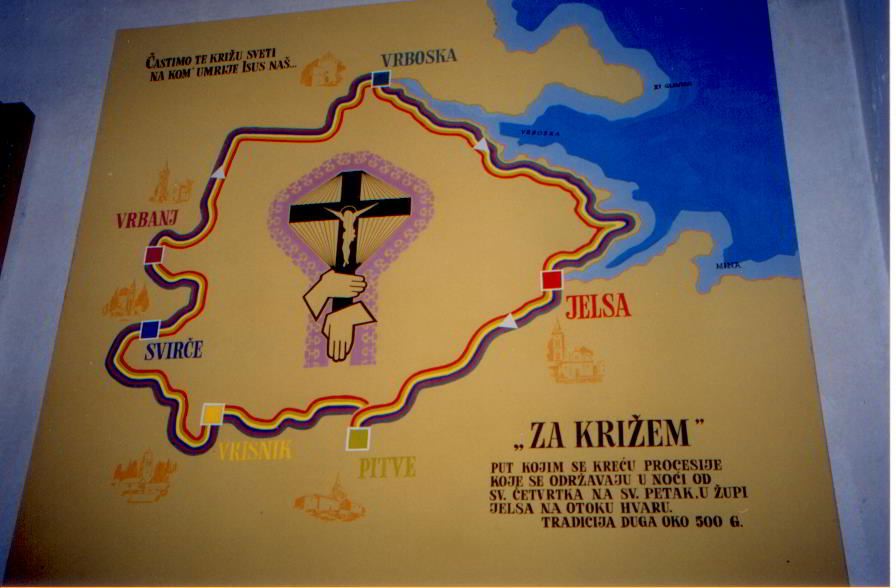 The six villages which form the Jelsa council are linked together for the procession, which is made up of six simultaneous processions. Led by their cross-bearer (krizonosa), a group sets out from each parish church more or less simultaneously at around 10.30pm on the evening of Maundy Thursday. Walking in a clockwise direction, they head for the next parish church, chanting prayers and hymns in unison or ancient harmonies. They carry candles and lanterns, which provide a mystical light as the processions file through the darkness. At each church, they stop for prayers, and the haunting harmonies of Mother Mary’s lament (Gospin plac) are sung. Then they move on to the next village. They walk through the night, covering some 20 kilometres, and arrive back at their home church by about 7am on Good Friday morning.
The six villages which form the Jelsa council are linked together for the procession, which is made up of six simultaneous processions. Led by their cross-bearer (krizonosa), a group sets out from each parish church more or less simultaneously at around 10.30pm on the evening of Maundy Thursday. Walking in a clockwise direction, they head for the next parish church, chanting prayers and hymns in unison or ancient harmonies. They carry candles and lanterns, which provide a mystical light as the processions file through the darkness. At each church, they stop for prayers, and the haunting harmonies of Mother Mary’s lament (Gospin plac) are sung. Then they move on to the next village. They walk through the night, covering some 20 kilometres, and arrive back at their home church by about 7am on Good Friday morning.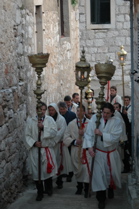
The procession: “Za Krizem”
 The six villages which form the Jelsa council are linked together for the procession, which is made up of six simultaneous processions. Led by their cross-bearer (krizonosa), a group sets out from each parish church more or less simultaneously at around 10.30pm on the evening of Maundy Thursday. Walking in a clockwise direction, they head for the next parish church, chanting prayers and hymns in unison or ancient harmonies. They carry candles and lanterns, which provide a mystical light as the processions file through the darkness. At each church, they stop for prayers, and the haunting harmonies of Mother Mary’s lament (Gospin plac) are sung. Then they move on to the next village. They walk through the night, covering some 20 kilometres, and arrive back at their home church by about 7am on Good Friday morning.
The six villages which form the Jelsa council are linked together for the procession, which is made up of six simultaneous processions. Led by their cross-bearer (krizonosa), a group sets out from each parish church more or less simultaneously at around 10.30pm on the evening of Maundy Thursday. Walking in a clockwise direction, they head for the next parish church, chanting prayers and hymns in unison or ancient harmonies. They carry candles and lanterns, which provide a mystical light as the processions file through the darkness. At each church, they stop for prayers, and the haunting harmonies of Mother Mary’s lament (Gospin plac) are sung. Then they move on to the next village. They walk through the night, covering some 20 kilometres, and arrive back at their home church by about 7am on Good Friday morning.
The tradition of the procession round the villages is believed to have started in the 16th century as a mark of “people power”, when the populace rebelled against their autocratic Venetian-dominated rulers. The parish priests play only a small part in the procession, which is organized by the lay brotherhood or confraternity (bratovstina). Previously, all the parishes had their own confraternity, but now there is only one in this group of villages, in Jelsa. The confraternities were founded in 1519 to maintain the churches and protect them against Turkish attack. It was a big commitment: for instance ten percent of the fishing catch would be given over for church needs. The confraternities were banned when Napoleon ruled Dalmatia (1806-1813), but some, as in Jelsa, re-emerged afterwards.
Cross-bearer: honour and duties
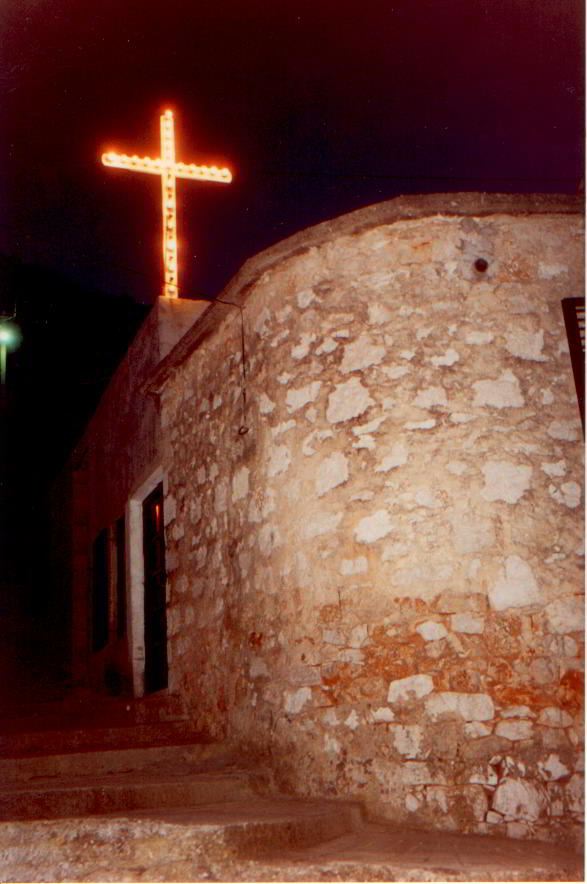 Carrying the cross is a great honour, and candidates put their names down years in advance. In 2007, a candidate to carry the cross for Jelsa would not have his turn until 2033, although the wait is shorter for the smaller villages. In Jelsa, the confraternity selects the applicants, whereas in the other villages candidates are approved by the parish councillors. There is no age limit, although of course the cross-bearer is expected to be fit enough to undertake the task. The lightest cross weighs 10 kilos, the heaviest 18. As each cross is covered with a veil for the processions, it can become very unwieldy if the night is windy. The cross-bearer has the honour and duty to carry the cross in every other procession during the year, and a large cross which is lit up at night is placed on the wall of his house as a mark of respect.
Carrying the cross is a great honour, and candidates put their names down years in advance. In 2007, a candidate to carry the cross for Jelsa would not have his turn until 2033, although the wait is shorter for the smaller villages. In Jelsa, the confraternity selects the applicants, whereas in the other villages candidates are approved by the parish councillors. There is no age limit, although of course the cross-bearer is expected to be fit enough to undertake the task. The lightest cross weighs 10 kilos, the heaviest 18. As each cross is covered with a veil for the processions, it can become very unwieldy if the night is windy. The cross-bearer has the honour and duty to carry the cross in every other procession during the year, and a large cross which is lit up at night is placed on the wall of his house as a mark of respect. 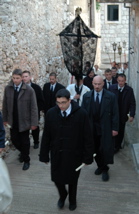 The cross-bearer chooses the group who will form his immediate entourage. There is no set number: he can choose as many or as few as he wishes. He will have a number of personal companions who will act as assistants and help him in case of difficulty. These are family members or close friends. If the cross-bearer finds himself unable to carry the cross the whole distance for any reason, his assistants will help him, although this rarely happens. Luka Tabak (left), cross-bearer for Pitve in 2007, had eight men around him. including his father Prosper. The assistants were dressed in dark suits, according to custom, while the cross-bearer and the flanking entourage wore the cream-coloured robes of the brotherhood. The entourage numbered 54: two led the way with tall lanterns, while the others were arranged in pairs, twenty-six to either side in front of the cross-bearer, and an equal number behind him, carrying tall gilt holders with candles (kandeliri), large votive candles (torci) and lanterns (ferali).
The cross-bearer chooses the group who will form his immediate entourage. There is no set number: he can choose as many or as few as he wishes. He will have a number of personal companions who will act as assistants and help him in case of difficulty. These are family members or close friends. If the cross-bearer finds himself unable to carry the cross the whole distance for any reason, his assistants will help him, although this rarely happens. Luka Tabak (left), cross-bearer for Pitve in 2007, had eight men around him. including his father Prosper. The assistants were dressed in dark suits, according to custom, while the cross-bearer and the flanking entourage wore the cream-coloured robes of the brotherhood. The entourage numbered 54: two led the way with tall lanterns, while the others were arranged in pairs, twenty-six to either side in front of the cross-bearer, and an equal number behind him, carrying tall gilt holders with candles (kandeliri), large votive candles (torci) and lanterns (ferali). The singers of the Mother’s lament are vital to the procession. In every church from start to finish, two lead singers intone the plaint, and a group of three or four make the response . Above the deep male voices the sound of a woman wailing emerges, a kind of overtone created by the vibrations produced between the singers. The singing is very specialized. None of the music is written down. Apart from learning the notes and words, the singers have to use extremely deep breaths, time the music exactly, and co-ordinate perfectly. Training usually starts at puberty for those boys who are interested, who have a potentially strong voice and a good musical ear. Dane Kordic, one of the singers from Pitve - known as the “Pitvan Pavarotti” - learned the Mother’s lament from the age of twelve from his father, despite being penalized at school for participating in religious rites. Dane has sung the lament for the Pitvan procession for many years.
Women's role
The cross-bearer is responsible for the organization of the procession. Female family members and friends have to plan several feasts for the event. Preparations start in earnest at the latest by mid-Lent. The torch- and lantern-bearers meet most evenings to practise the singing, and of course food and drink have to be provided for them. On Maundy Thursday there is a mass in the early evening, after which the cross-bearer provides a supper, usually of fish soup and fish dishes, before the participants gather again in the church at about 9.30pm for the start of the procession. After the procession returns to its home village and the closing rituals are completed, a full breakfast is served to all the cross-bearer’s entourage. The women who help serve and clear up may well have done the all-night walk too. On Easter Sunday or Monday, the cross-bearer hosts a festive lunch for all, with several meat courses and endless varieties of cakes. Food from the feast may be sent round to any elderly or sick people in the village. Later in the week, specially baked biscuits are given to all the villagers.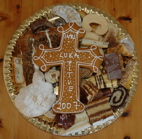 All those who have helped behind the scenes, mainly women, are treated to a festive lunch or dinner by the cross-bearer.
All those who have helped behind the scenes, mainly women, are treated to a festive lunch or dinner by the cross-bearer.
Originally, women did not participate in the processions, but now they can take part, and many do so year after year. They walk behind the men who follow the cross-bearer and his companions, all in double file, and they sing their own prayers which are completely different from the male chants. As everyone sings at full volume, the listener has a bizarre impression of some strange competition, but such is the tradition. The route of the processions has altered slightly over the years: before the asphalt roads were built linking the inland villages, the processions followed the old stony paths, providing more hardship for the cross-bearer, who traditionally walks barefoot or in socks. Nowadays, the processions follow the roads, apart from the Jelsa procession which still uses the old track through the fields to come up to Pitve.
 All those who have helped behind the scenes, mainly women, are treated to a festive lunch or dinner by the cross-bearer.
All those who have helped behind the scenes, mainly women, are treated to a festive lunch or dinner by the cross-bearer.Originally, women did not participate in the processions, but now they can take part, and many do so year after year. They walk behind the men who follow the cross-bearer and his companions, all in double file, and they sing their own prayers which are completely different from the male chants. As everyone sings at full volume, the listener has a bizarre impression of some strange competition, but such is the tradition. The route of the processions has altered slightly over the years: before the asphalt roads were built linking the inland villages, the processions followed the old stony paths, providing more hardship for the cross-bearer, who traditionally walks barefoot or in socks. Nowadays, the processions follow the roads, apart from the Jelsa procession which still uses the old track through the fields to come up to Pitve.
Local variations
There are other slight variations in the format: for instance, most of the processions walk straight through Pitve to the church, but the Pitvan procession walks round the village. Unlike the other villages' cross-bearers, the Pitvan cross-bearer usually chooses to walk up to the church of Our Lady of Health in Jelsa, in addition to stopping at jelsa's main parish church. The Jelsa procession is led by a "path-beater" called a battistrada, whereas the other villages may or may not have an informal guide who co-ordinates the singing and walking. Jelsa has a ceremony the week before the procession, in which last year’s cross-bearer passes the cross to this year’s, but this does not happen in all the villages. In Jelsa alone, the returning cross-bearer is expected to run the 20 metres or so from the sea-front to greet the parish priest, before going round to the tiny chapel of Sveti Ivan, then following a circuit through the oldest part of Jelsa to reach the main parish church. In Pitve, a priest may or may not attend the return, depending on his commitments in other parishes: if he does, he falls in behind the cross-bearer for the last part of the walk round the church: in 2002 Don Emil was present to welcome cross-bearer Ivo Barbic back (right). 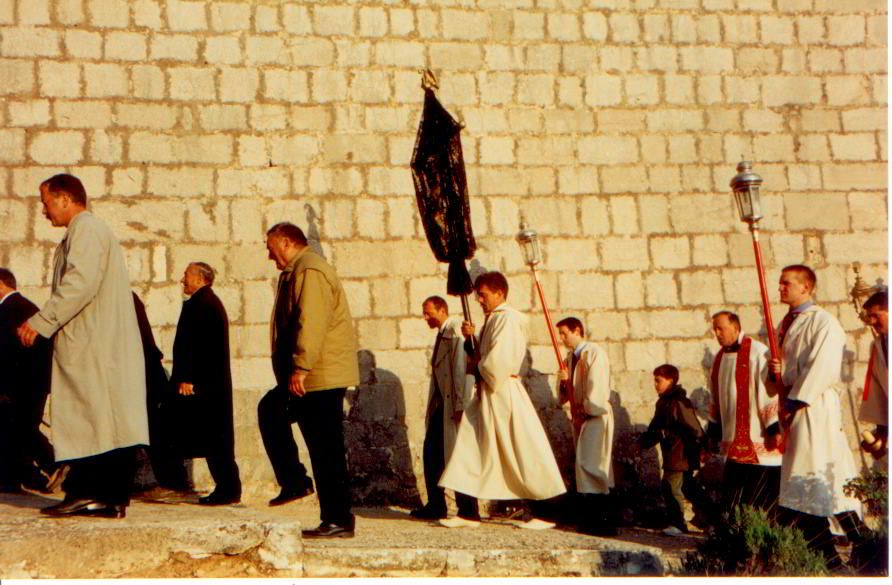

In most churches on the way, the visiting cross-bearer kneels and keeps hold of the cross throughout the lament, whereas in the Jelsa church the cross is taken from him.
Another variant in the programming is that the subsidiary procession from Jelsa’s main church to the church of Our Lady of Health up the hill takes place on Maundy Thursday afternoon, whereas in Pitve, by contrast, the parallel procession round the two parts of the village takes place on Good Friday evening, following the service commemorating the Passion of Christ, which is sung, usually by one of the cross-bearer’s entourage. During the procession, everyone carries lighted candles, and the men sing different chants from those of the previous night. At intervals the congregation kneels down, given the signal by a rattle, as bells are not used during these holy days. The Good Friday evening service and procession last some three hours, testing the vocal and physical stamina of all concerned. Many participants will have gone to work or worked in their fields during the day, surviving on minimal sleep.
Historical hardships
The Easter-time processions have held their unbroken tradition against the odds. In the autumn of 1943, the Nazis invaded Dalmatia, so the procession could not be held on the island under the occupation in 1944. However, large numbers of Dalmatians had been evacuated by the British navy to El Shatt in Egypt, and they organized the procession there. Survivors from the refugee camps, where many died of diseases, say the British camp commander, a Major Becker, was most surprised at the request to hold the procession, as he had assumed they were Godless communists. The procession was held, the continuous tradition preserved, and relations between the camp guards and the refugees became more cordial through greater mutual understanding.
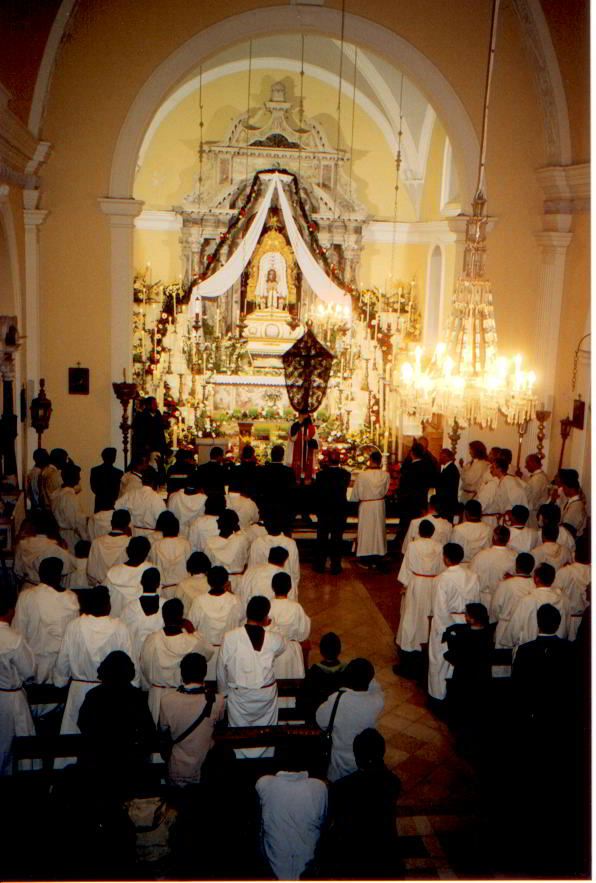 After the second world war came communism, under which religious practices were not banned, but strongly discouraged. Events such as processions were allowed, but only if permission was granted by the authorities. One year, in the early 1950s, the main procession “Za Krizem” was licensed, but the subsidiary procession from Jelsa’s main church up the hill to the church of Our Lady was banned. The cross-bearer Tomas Makjanic cried in frustration, then gathered his courage and led the congregation out of the church through the town and up the hill. Those who participated describe the unnerving feeling of passing the watching policemen and officials, wondering if they would be stopped and arrested. They were allowed to pass, but the cross-bearer was later punished with a short spell in prison.
After the second world war came communism, under which religious practices were not banned, but strongly discouraged. Events such as processions were allowed, but only if permission was granted by the authorities. One year, in the early 1950s, the main procession “Za Krizem” was licensed, but the subsidiary procession from Jelsa’s main church up the hill to the church of Our Lady was banned. The cross-bearer Tomas Makjanic cried in frustration, then gathered his courage and led the congregation out of the church through the town and up the hill. Those who participated describe the unnerving feeling of passing the watching policemen and officials, wondering if they would be stopped and arrested. They were allowed to pass, but the cross-bearer was later punished with a short spell in prison.
If Good Friday fell on a schoolday or working day, children and employees were expected to attend: anyone who took the day off because of tiredness following the all-night walk could expect to be penalized. This was especially hard on the schoolchildren, who might take part in the procession for the first time during their first year at school, when they were seven: the low marks they would receive if they were too tired at school the next day could even lead to victimization, which might jeopardize their progression up into the next grade in the following school year. There are many today who can tell of the injustices they experienced because of their open participation in a public display of faith during the communist years.
During the war of aggression against Croatia (1991-1995), Hvar island was blockaded for a period until mid-1992, and the tiny airstrip which serves for medical and firefighting emergencies was bombed. The processions were held regardless.
Easter joys
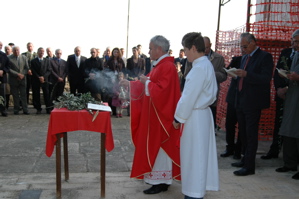 In modern times, the traditions can be practised without fear. As everywhere in the Christian world, Palm Sunday marks the start of the build-up to Easter Sunday. The local custom is for the congregation to take bundles of olive branches, sometimes mixed with branches of laurel, to be blessed in a ceremony which generally takes place outdoors. The b
In modern times, the traditions can be practised without fear. As everywhere in the Christian world, Palm Sunday marks the start of the build-up to Easter Sunday. The local custom is for the congregation to take bundles of olive branches, sometimes mixed with branches of laurel, to be blessed in a ceremony which generally takes place outdoors. The b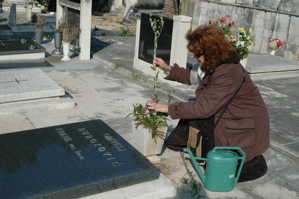 undles are placed along the church wall. In front of the church a table is loaded with individual olive branches. The priest blesses all the olive branches and the congregation, then leads a short procession round the church. This is followed by mass inside the church.
undles are placed along the church wall. In front of the church a table is loaded with individual olive branches. The priest blesses all the olive branches and the congregation, then leads a short procession round the church. This is followed by mass inside the church.
Another variant in the programming is that the subsidiary procession from Jelsa’s main church to the church of Our Lady of Health up the hill takes place on Maundy Thursday afternoon, whereas in Pitve, by contrast, the parallel procession round the two parts of the village takes place on Good Friday evening, following the service commemorating the Passion of Christ, which is sung, usually by one of the cross-bearer’s entourage. During the procession, everyone carries lighted candles, and the men sing different chants from those of the previous night. At intervals the congregation kneels down, given the signal by a rattle, as bells are not used during these holy days. The Good Friday evening service and procession last some three hours, testing the vocal and physical stamina of all concerned. Many participants will have gone to work or worked in their fields during the day, surviving on minimal sleep.
Historical hardships
The Easter-time processions have held their unbroken tradition against the odds. In the autumn of 1943, the Nazis invaded Dalmatia, so the procession could not be held on the island under the occupation in 1944. However, large numbers of Dalmatians had been evacuated by the British navy to El Shatt in Egypt, and they organized the procession there. Survivors from the refugee camps, where many died of diseases, say the British camp commander, a Major Becker, was most surprised at the request to hold the procession, as he had assumed they were Godless communists. The procession was held, the continuous tradition preserved, and relations between the camp guards and the refugees became more cordial through greater mutual understanding.
 After the second world war came communism, under which religious practices were not banned, but strongly discouraged. Events such as processions were allowed, but only if permission was granted by the authorities. One year, in the early 1950s, the main procession “Za Krizem” was licensed, but the subsidiary procession from Jelsa’s main church up the hill to the church of Our Lady was banned. The cross-bearer Tomas Makjanic cried in frustration, then gathered his courage and led the congregation out of the church through the town and up the hill. Those who participated describe the unnerving feeling of passing the watching policemen and officials, wondering if they would be stopped and arrested. They were allowed to pass, but the cross-bearer was later punished with a short spell in prison.
After the second world war came communism, under which religious practices were not banned, but strongly discouraged. Events such as processions were allowed, but only if permission was granted by the authorities. One year, in the early 1950s, the main procession “Za Krizem” was licensed, but the subsidiary procession from Jelsa’s main church up the hill to the church of Our Lady was banned. The cross-bearer Tomas Makjanic cried in frustration, then gathered his courage and led the congregation out of the church through the town and up the hill. Those who participated describe the unnerving feeling of passing the watching policemen and officials, wondering if they would be stopped and arrested. They were allowed to pass, but the cross-bearer was later punished with a short spell in prison.If Good Friday fell on a schoolday or working day, children and employees were expected to attend: anyone who took the day off because of tiredness following the all-night walk could expect to be penalized. This was especially hard on the schoolchildren, who might take part in the procession for the first time during their first year at school, when they were seven: the low marks they would receive if they were too tired at school the next day could even lead to victimization, which might jeopardize their progression up into the next grade in the following school year. There are many today who can tell of the injustices they experienced because of their open participation in a public display of faith during the communist years.
During the war of aggression against Croatia (1991-1995), Hvar island was blockaded for a period until mid-1992, and the tiny airstrip which serves for medical and firefighting emergencies was bombed. The processions were held regardless.
Easter joys
 In modern times, the traditions can be practised without fear. As everywhere in the Christian world, Palm Sunday marks the start of the build-up to Easter Sunday. The local custom is for the congregation to take bundles of olive branches, sometimes mixed with branches of laurel, to be blessed in a ceremony which generally takes place outdoors. The b
In modern times, the traditions can be practised without fear. As everywhere in the Christian world, Palm Sunday marks the start of the build-up to Easter Sunday. The local custom is for the congregation to take bundles of olive branches, sometimes mixed with branches of laurel, to be blessed in a ceremony which generally takes place outdoors. The b undles are placed along the church wall. In front of the church a table is loaded with individual olive branches. The priest blesses all the olive branches and the congregation, then leads a short procession round the church. This is followed by mass inside the church.
undles are placed along the church wall. In front of the church a table is loaded with individual olive branches. The priest blesses all the olive branches and the congregation, then leads a short procession round the church. This is followed by mass inside the church. The blessed olive branches are taken home, and some are placed on family graves later in the day (right).
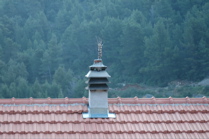
Another custom is to place a blessed olive branch or cluster of olive and laurel branches on a newly completed roof (left): devout builders keep a stock of them for projects they will complete during the year.
Holy Saturday is marked by a service commemorating the Vigil (Bdjenje) at Jesus’ grave. A major part of this long service is the blessing of a fire outside the church, and the lighting of candles inside, symbolizing the coming of the Light with Jesus’ Resurrection. The Easter Sunday mass is the culmination of the church celebrations, and is inevitably followed by family feasting and rounds of friends visiting. Most families still paint eggs in the traditional way, and many hang finely decorated eggs around their homes. Easter is probably a bigger celebration than Christmas in Dalmatia.
Holy Saturday is marked by a service commemorating the Vigil (Bdjenje) at Jesus’ grave. A major part of this long service is the blessing of a fire outside the church, and the lighting of candles inside, symbolizing the coming of the Light with Jesus’ Resurrection. The Easter Sunday mass is the culmination of the church celebrations, and is inevitably followed by family feasting and rounds of friends visiting. Most families still paint eggs in the traditional way, and many hang finely decorated eggs around their homes. Easter is probably a bigger celebration than Christmas in Dalmatia.
© Vivian Grisogono 2007

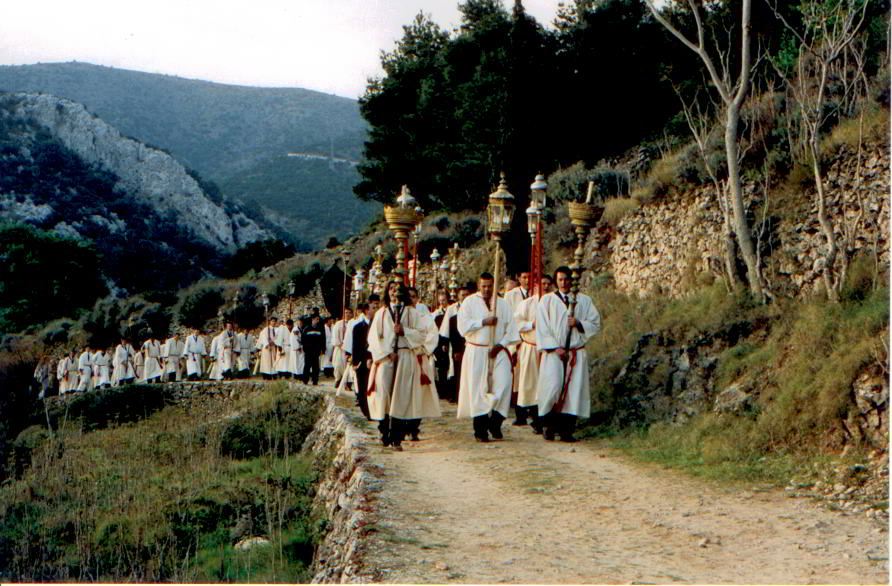 Easter is a major festival in the Christian calendar, celebrated joyously all round the world wherever Christianity is practised. In most Catholic countries, there are processions, especially on Good Friday, with traditional
Easter is a major festival in the Christian calendar, celebrated joyously all round the world wherever Christianity is practised. In most Catholic countries, there are processions, especially on Good Friday, with traditional 
